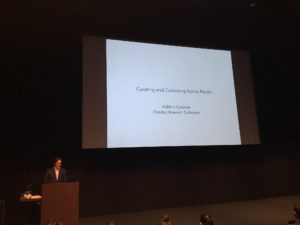Curating Time-based works
Laura Belik on the Arts + Design Wednesdays @ BAMPFA | Curation Across Disciplines talk
Curating and Collecting Across Media with Aebhric Coleman, November 15, 2017.
 It might seem hard to believe for some of the younger generation today, but video and electronic art was not always a popular form of expression. “Today this kind of media is progressively being used by contemporary artists somehow through their work,” reflected Aebhric Coleman, director of the Kramlich Collection, the most influential private collection of new media/time based art in the world. Pamela and Richard Kramlich, the San Francisco-based collectors were already involved with the art world as members of the board of trustees at the San Francisco Museum of Modern Art, where they were introduced to this kind of media, and from there, started buying their first pieces back in the 1980’s.
It might seem hard to believe for some of the younger generation today, but video and electronic art was not always a popular form of expression. “Today this kind of media is progressively being used by contemporary artists somehow through their work,” reflected Aebhric Coleman, director of the Kramlich Collection, the most influential private collection of new media/time based art in the world. Pamela and Richard Kramlich, the San Francisco-based collectors were already involved with the art world as members of the board of trustees at the San Francisco Museum of Modern Art, where they were introduced to this kind of media, and from there, started buying their first pieces back in the 1980’s.
The Kramlich Collection today holds 150 Media Artworks from 90 artists across 23 countries. Although different institutions seem to understand Media Art differently, the Collection defines it (roughly) as a time based work, in a digital platform that needs display equipment. They look for pieces that are innovative and challenging both as form and content. Coleman emphasizes that the importance of having works from around the globe is the varied and unique content. The Kramlich Collection is often involved with museums and other projects. The main example of this is the New Art Trust, founded in 1997, with has the means and the goal to promote research and conservation for media art. Electronic art forms require specific care, and for that reason the Trust partnered with three major museums—MoMA, SFMOMA, and Tate. Coleman also talked about one of the most recent projects from the New Art Trust called Media Matters, an open website that gives information on how to conserve time-based art. The Kramlich’s consider it extremely important to discuss what the best ways are to keep those new technological art works, because of how new those practices still are, and how we can acknowledge their value also through their proper maintenance: “In media art, curatorial and conservation works have been merging together. You can’t curate these works without knowing about conservation, and vice-versa”, Coleman reiterates.
The curatorial process for media art at the Kramlich Collection works in two parts, explained Coleman: Spatial and Content. The spatial characteristics are crucial for properly maintaining and displaying the works. With this in mind, the collectors hired the highly acclaimed architecture firm Herzog & de Meuron to design their new private home and collections space in Napa, CA. Coleman emphasized how the detailed works of architects and engineers are crucial for the pieces of work. Not only is there a carefully thought out floorplan display for the best interactions with the media, but also there is also a concern with how to isolate the sound and light from one installation to the other, and how to have a reliable wireless system for internal communication as well as to see the works.
Coleman’s responsibilities as a director of the Kramlich Collection show us how broad the works of a curator can be. When it comes to media art today, it is clear that the knowledge of art practice needs to encapsulate a much larger scope of skills that we imagine. Time-based art is equally complex.
Lauren Belik (PhD Student, Architecture) reviewed the November 15, 2017 talk,Curating and Collecting Across Media with Aebhric Coleman, as part of the Fall 2017Arts + Design Wednesdays @ BAMPFA series. To learn more about the series, see below:
What does it mean to curate? How has the role of the curator changed in our contemporary moment? Does the curator function differently in the performing arts, the visual arts, film, and in the fields of science and technology? And, how has curating changed as it responds to new forms of cultural and digital participation? When curation has become a popular metaphor in many domains –from food, to music, to social media — how do we define this expanded practice?
Co-taught by Shannon Jackson, Associate Vice Chancellor of the Arts + Design; Natasha Boas, independent curator, art historian and critic; and Eric Siegel, Director of the University of California Botanical Garden at Berkley, Arts + Design Wednesdays @ BAMPFA will explore this theme with some of the most innovative and incisive writers, artists and scholars of our time. Learn more here.
